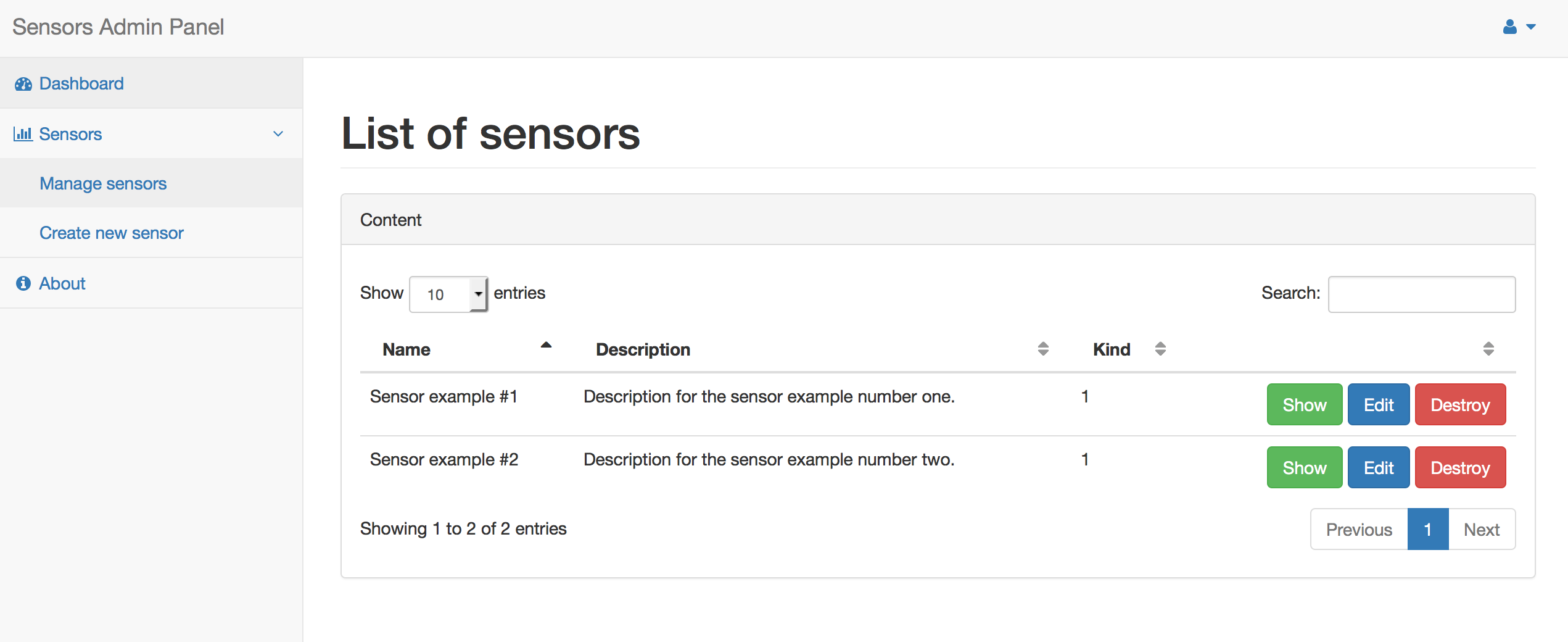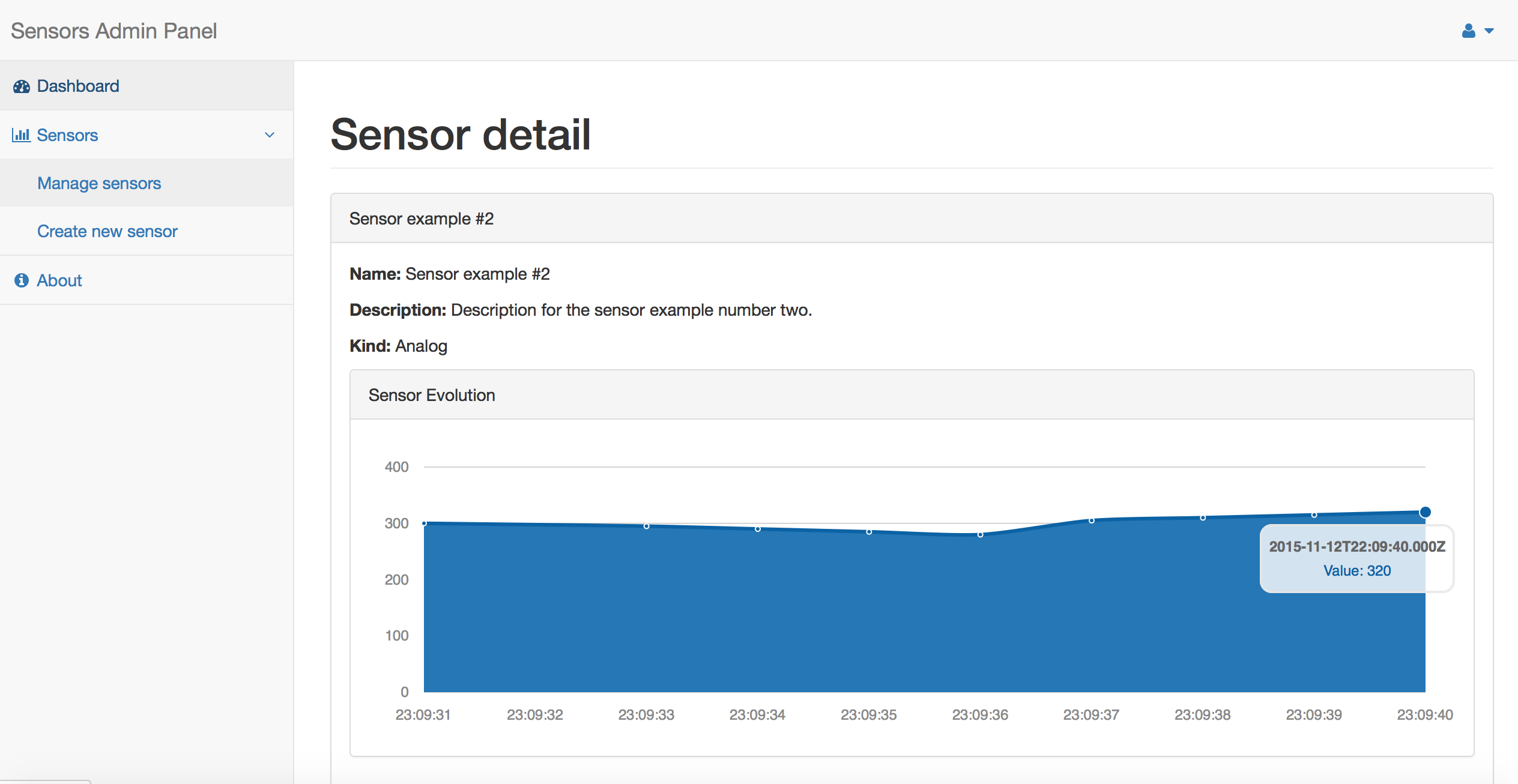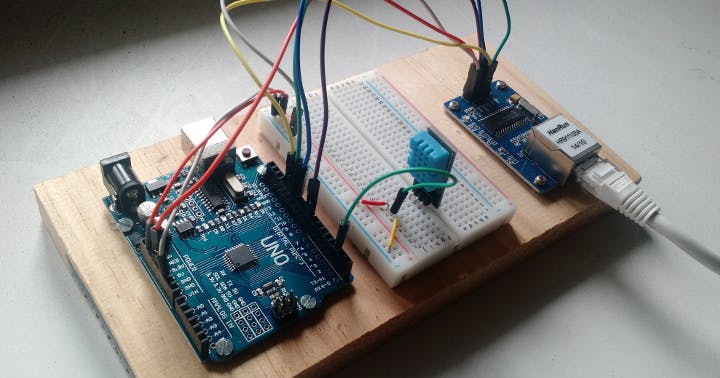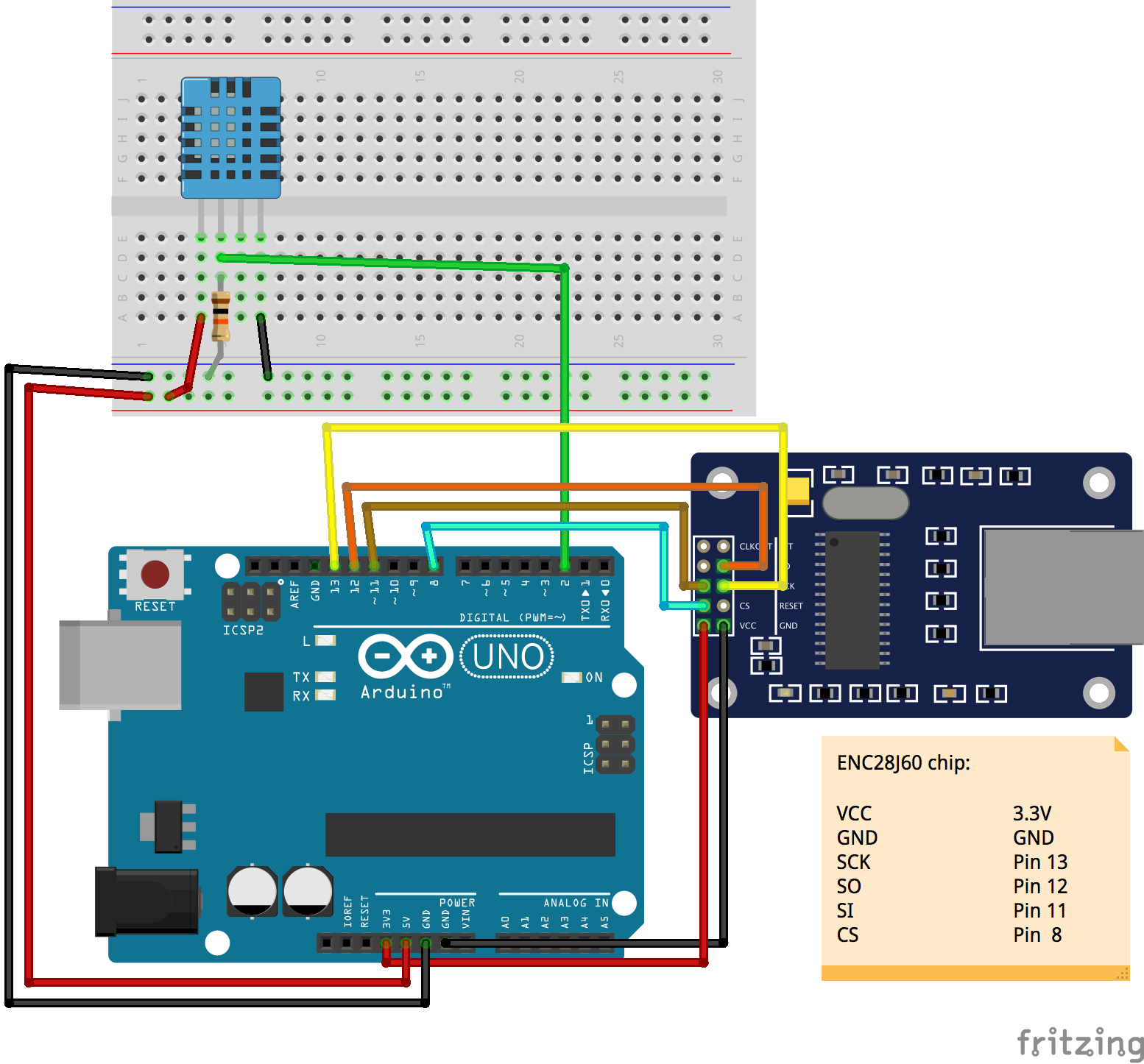- Published on
Physical software made easy with Arduino and Ruby on Rails
- Authors
- Name
- Iván González Sáiz
- @dreamingechoes
One of the fields of computer science that attracts me the most is the physical software. Another is, as you can see on my page, the web development. So today we will combine both fields to have some fun. Let's go!
So... what's the idea?
Thinking about combine both fields, the simplest and useful idea that I thought is to develop a kind of cheap system with which you could track the values of all the sensors placed in our house. The challenge is to keep the cost of the system below the 20€.
Ok, so in order to accomplish the challenge, we'll need some hardware:
An Arduino board or compatible (around 5€ on eBay).
A protoboard where connect all the components and some wires (easily no more than 5€ on eBay).
An ethernet adaptor for the Arduino board like the one used in this example, the ENC28J60 Ethernet chip (again, around 5€ on eBay).
Some kind of sensor to get measures of your physical environment like the one used in this example, a DHT11 Temperature and humidity sensor (below 2€ on eBay).
So the final cost is around 17/18€, under the 20€ limit. Yeah! Well, we already have the hardware, but we need the software where all the data are going to be stored in order to be able to track all this measures. And what better way to do this than with an application in Ruby on Rails?
Let's build our simple Rails application
We need some kind of web administration panel, so that our Rails application will have listings to display all the information we store in it, and a RESTful API through which we receive measurements from our Arduino board. Please read my last post about creating a super fancy API with Grape.
For this example, I use the Bootstrap Admin theme SB Admin Base V2 gem that I made to integrate this Bootstarp theme with my application (you could find it here), so at the end I have something like this:


If you feel lazy and you don't want to spend the time developing this Rails application, you could check the one I made in this Github repo.
Ok, we have the Rails application, but what about the hardware?
Let's now go to the second part of our system, the hardware. For this example, I use an Arduino Uno board, an ENC28J60 Ethernet chip, and a DHT11 Temperature and humidity sensor to send this measures (temperature and humidity) to my Rails application. I only use one sensor, but you can attach to the Arduino Board as many sensors as you want.
Wiring all properly, we'll have something like this:

Here is the schema made with Fritzing of the example:

I will not go into detail about how I wired everything, because it's better to use the official documentation or datasheet of each sensor or component you'll use. This is only an example.
Arduino, do as I command!
We have to set our Arduino to read the values that the sensor give us, and send them to our RESTful API. For this we'll make use of two libraries, one for managing the temperature and humidity sensor, and another to use the ethernet chip. But first of all, let's install the Arduino IDE.
Go to the Arduino download page and download and install the Arduino software for your operating system. Once this is done, we'll have to download the libraries that I mention before, you can do on these links:
Here you have the instructions to import this libraries to our Arduino IDE.
IDE installed, libraries configured... Let's do some coding!
I suggest you go through these guides and tutorials of the official Arduino page to familiarize you with the environment and be able to well understand the code I'll show, specially if you're not familiar with C/C++ language (language that we'll use to program our Arduino board).
The program that will load in our Arduino board is quite simple, with two main parts: the loop and sendToAPI functions. The loop function looks like this:
void loop () {
int temp_val = 0;
int hum_val = 0;
static Dht11 sensor(DHT_DATA_PIN);
word len = ether.packetReceive();
word pos = ether.packetLoop(len);
// Control when we could execute the next HTTP request
if (millis() > timer)
switch (sensor.read()) {
case Dht11::OK:
switch (next) {
case 1:
// Read humidity level
Serial.print("Humidity (%): ");
hum_val = sensor.getHumidity();
Serial.println(hum_val);
if (millis() > timer) {
sendToAPI(1, hum_val);
timer = millis() + 5000;
}
next = 2;
// Added delay to allow the sensor to obtain measurements correctly
delay(2000);
break;
case 2:
// Read temperature level
Serial.print("Temperature (C): ");
temp_val = sensor.getTemperature();
Serial.println(temp_val);
if (millis() > timer) {
sendToAPI(2, temp_val);
timer = millis() + 5000;
}
next = 1;
// Added delay to allow the sensor to obtain measurements correctly
delay(2000);
break;
}
break;
// Manage ERROR_CHECKSUM DHT11 error
case Dht11::ERROR_CHECKSUM:
Serial.println("Checksum error");
break;
// Manage ERROR_TIMEOUT DHT11 error
case Dht11::ERROR_TIMEOUT:
Serial.println("Timeout error");
break;
default:
Serial.println("Unknown error");
break;
}
}
}
This function, as its name suggests, is executed in a loop for as long as the Arduino board is on. As you could see, in this function we constantly read the value of the sensor, controlling the response of it (with the case directive), and executes the sendToAPI function when possible to send the data to our Rails application. (you could check the official documentation of the DHT11 library in order to better understand every piece of this code here).
The sendToAPI function looks like this:
/*
* function sendToAPI
*
* int id: ID of the sensor on the final RESTful API application
* int value: value of the sensor measure that will be send
*/
static void sendToAPI (int id, int value) {
byte sd = stash.create();
// Assign the values to the request params.
stash.print("token=");
stash.print(TOKEN);
stash.print("&value=");
stash.print(value);
stash.print("&sensor_id=");
stash.print(id);
stash.save();
int stash_size = stash.size();
// Compose the http POST request, taking the headers below and appending
// previously created stash in the sd holder.
Stash::prepare(PSTR("POST https://$F$F HTTP/1.0" "\r\n"
"Host: $F" "\r\n"
"Content-Length: $D" "\r\n"
"\r\n"
"$H"),
website, PSTR("/api/v1/measures"), website, stash_size, sd);
// Send the packet. This also releases all stash buffers once done.
// Save the session ID so we can watch for it in the main loop.
session = ether.tcpSend();
}
This function uses the objects that the Ethernet library give us to compose the parameters query, prepare the POST request to our endpoint, and send the information (you could check the official documentation of this library in order to better understand every piece of this code here).
If we put together this two main parts of the code with the rest of the program, we'll have the final code that we're going to upload to our Arduino board:
#include <EtherCard.h>
#include "Arduino.h"
#include "Dht11.h"
// RESTful API token for authentication.
// Change it to the one you need.
#define TOKEN "ac4bd425935c350a54aabb362906283f"
// Ethernet interface mac address, must be unique on the LAN
byte mymac[] = { 0x74,0x69,0x69,0x2D,0x30,0x31 };
// Global variables
const char website[] PROGMEM = "sensors-admin-panel.herokuapp.com";
static byte session;
int next = 1;
static uint32_t timer;
enum {
DHT_DATA_PIN = 2,
SERIAL_BAUD = 9600,
POLL_DELAY = 2000,
};
byte Ethernet::buffer[700];
Stash stash;
/*
* function sendToAPI
*
* int id: ID of the sensor on the final RESTful API application
* int value: value of the sensor measure that will be send
*/
static void sendToAPI (int id, int value) {
byte sd = stash.create();
// Assign the values to the request params.
stash.print("token=");
stash.print(TOKEN);
stash.print("&value=");
stash.print(value);
stash.print("&sensor_id=");
stash.print(id);
stash.save();
int stash_size = stash.size();
// Compose the http POST request, taking the headers below and appending
// previously created stash in the sd holder.
Stash::prepare(PSTR("POST https://$F$F HTTP/1.0" "\r\n"
"Host: $F" "\r\n"
"Content-Length: $D" "\r\n"
"\r\n"
"$H"),
website, PSTR("/api/v1/measures"), website, stash_size, sd);
// Send the packet. This also releases all stash buffers once done.
// Save the session ID so we can watch for it in the main loop.
session = ether.tcpSend();
}
void setup () {
// Setup the Ethernet chip
Serial.begin(57600);
Serial.println("\n[API Client]");
if (ether.begin(sizeof Ethernet::buffer, mymac) == 0)
Serial.println(F("Failed to access Ethernet controller"));
if (!ether.dhcpSetup())
Serial.println(F("DHCP failed"));
ether.printIp("IP: ", ether.myip);
ether.printIp("GW: ", ether.gwip);
ether.printIp("DNS: ", ether.dnsip);
if (!ether.dnsLookup(website))
Serial.println(F("DNS failed"));
ether.printIp("SRV: ", ether.hisip);
}
void loop () {
int temp_val = 0;
int hum_val = 0;
static Dht11 sensor(DHT_DATA_PIN);
word len = ether.packetReceive();
word pos = ether.packetLoop(len);
// Control when we could execute the next HTTP request
if (millis() > timer)
switch (sensor.read()) {
case Dht11::OK:
switch (next) {
case 1:
// Read humidity level
Serial.print("Humidity (%): ");
hum_val = sensor.getHumidity();
Serial.println(hum_val);
if (millis() > timer) {
sendToAPI(1, hum_val);
timer = millis() + 5000;
}
next = 2;
// Added delay to allow the sensor to obtain measurements correctly
delay(2000);
break;
case 2:
// Read temperature level
Serial.print("Temperature (C): ");
temp_val = sensor.getTemperature();
Serial.println(temp_val);
if (millis() > timer) {
sendToAPI(2, temp_val);
timer = millis() + 5000;
}
next = 1;
// Added delay to allow the sensor to obtain measurements correctly
delay(2000);
break;
}
break;
// Manage ERROR_CHECKSUM DHT11 error
case Dht11::ERROR_CHECKSUM:
Serial.println("Checksum error");
break;
// Manage ERROR_TIMEOUT DHT11 error
case Dht11::ERROR_TIMEOUT:
Serial.println("Timeout error");
break;
default:
Serial.println("Unknown error");
break;
}
}
}
Note: Tell me in the comments or via message if you need to go into detail on this code if there is anything you don't understand well, I have not done to avoid excessively increasing the post.
Now you could upload this code with the Arduino IDE to your board, plug your Arduino, connect an ethernet cable, and see what's happening on your Rails application. It's alive! Dammit, I feel like MacGyver! Yeah!

Any place where I can see the result?
Yeah! Here you have the Admin panel Github repo and here the Arduino code for this example, so you can clone it, change it, play with it... whatever you want! :smile:
If you don't want to play with the example repo, here you have a working example mounted on Heroku.
Enjoyed this article?
Stay in the loop
Get notified when I publish new articles about engineering leadership, remote teams, and building better tech cultures. No spam, unsubscribe anytime.